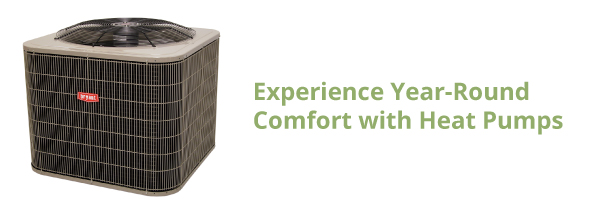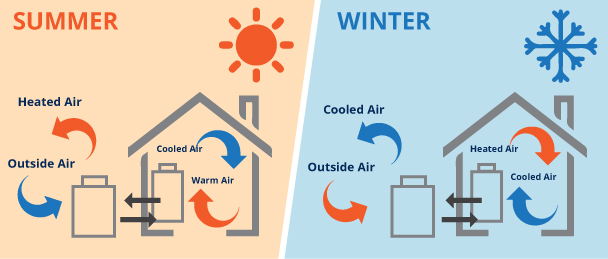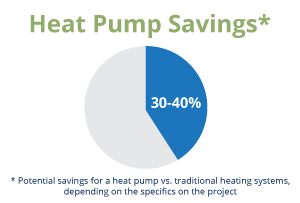Ask Our Experts: What is a Heat Pump?
December 27, 2021 | 5:27 pmNote: Article originally published on July 14, 2014. Content and graphics revised on December 27, 2021.
Question for Our Experts
What is a heat pump? Air conditioners are pretty straightforward. So are furnaces. But what is a heat pump – and how can something with the word “heat” in its name actually cool your home?
Our Experts’ Answer:
Experience Year Round Comfort with Heat Pumps
The cold winter months seem to be the perfect time to talk about heat pumps. Despite the fact that most people have no problem understanding how an air conditioner works, many still struggle to understand the basics of a heat pump.
So while some out there wait for their next delivery of oil, gas or pellets for their furnace or stove, let’s take a look at just how heat pumps work and why they should be high on the list of options for any home or office heating, ventilation and air conditioning (HVAC) system.
Table of Contents
- What Is a Heat Pump?
- Heat Pumps 101
- Types of Heat Pump Systems
- Heat Pump Efficiency
- Heat Pump System Costs
- Pros and Cons of a Heat Pump System
- Heat Pump vs. Furnace/Air Conditioner Combination
- Choosing the Ideal HVAC Solution
What Is a Heat Pump?
Taking the words at face value, a heat pump simply pumps heat from one place to another. It really is that simple.
Getting a little more technical, the natural laws of thermodynamics dictate that heat flows from one place to another when a temperature difference exists between the two locations. When this difference exists, heat flows from the warmer area to the cooler area. Believe it or not, this flow of heat will occur regardless of the actual temperatures involved.
Perhaps that’s one reason why people have such a hard time understanding heat pumps. They just don’t understand how it can be possible to get heat from a cold, wintry day and use it to warm up a home or office to about 70 degrees.
Heat Pumps 101
As we said above, heat flows from a warm source to a cooler destination, called the sink. So how then do we extract heat from a cold source, such as the cold chill of a 35 degree winter day? We put the air in contact with something even colder. That’s where our heat pump comes in.
Heat pumps include several different components, but one of the most important for explaining this process is the set of coils that contains the refrigerant. On that 35 degree winter day, the key to a heat pump’s operation is that the refrigerant in the coils is cooled to less than 35 degrees. By doing so, the heat pump gathers heat from the outside air and into the refrigerant in the coils. The heat pump then uses the refrigerant cycle to make use of the temperature increase of the refrigerant and transfer it to the inside of the home or office by way of the inside ducting.
In the summer, the heat pump simply works in reverse. Heat will be gathered by the ducting from the inside of the home, then the heat pump will use the refrigerant cycle and the coils to dump this excess heat to the outside air.
Types of Heat Pump Systems
Traditionally, there has been one major consideration to make when looking at heat pumps – the source used by the heat pump to support the heat transfer process.
There are two primary sources associated with heat pumps – air source and ground source. An air-source heat pump is the conventional type discussed in the previous section. In an air-source heat pump, the refrigerant coils are placed in contact with the outside air.
The temperature of the outside air determines the point at which the heat pump must operate. For those of us living in northern climates, that means a very wide range of operating temperatures throughout a typical winter.
Ground-source heat pumps are more commonly known as geothermal heat pumps. The significant advantage of a ground-source heat pump is that the refrigerant is circulated through a loop that is buried in the ground. Depending on the latitude of the installation, once the refrigerant loop gets down below about 20 feet, the ground maintains a temperature between about 50 and 60 degrees.
The consistency of the ground temperature provides a significant advantage on cold winter days, especially once the outside air drops below freezing. For this reason, ground-source heat pumps are generally more efficient and more effective at lower temperatures than traditional air-source heat pumps.
Recent advances in heat pump technology have moved beyond the traditional single-stage designs to multistage and variable speed designs. Whereas traditional single-stage heat pumps run at full capacity regardless of the system requirements, multistage and variable-speed designs are programmed to run the system at operating points that match the outside conditions and the heating or cooling requirements. In practical terms, this simply means that the heat pump only works as hard as it needs to – never more, and never less. This way, you save both money and energy as compared to a single-stage system.
Heat Pump Efficiency
So how efficient is a heat pump? Manufacturers and government agencies rate heat pump efficiency in two ways: SEER and HSFP ratings. For both of these ratings, a higher number corresponds to a more efficient unit.
SEER stands for seasonal energy efficiency rating. From a technical perspective, SEER is based on the performance of the heat pump while in cooling mode. It is equal to the ratio of energy used to pump warm air outside divided by the electricity used by the unit. From a practical standpoint, you should look for a SEER between 14 and 18 when purchasing a heat pump.
HSFP is the heating seasonal performance factor. HSFP is the heat pump efficiency rating for the unit operating in heating mode. HSFP is not a simple ratio like SEER because heating often involves other system parameters like backup heat and defrost modes. Generally, HVAC customers should look for HSFP ratings over 8. In the case of some of the best-rated heat pumps from Bryant, the HSFP is 13.
Does all of this translate to actually saving money with a heat pump system?
Heat Pump System Costs
The cost of a heat pump system will primarily be driven by the size of the unit, which in turn is driven by the size of the home or office. As a result, the cost to install and run different types of heat pump systems can vary quite a bit.
In general, air-source heat pumps are cheaper than ground-source heat pumps due to the simpler design and installation. In addition to the difference in the heat pump system, ground-source heat pump systems also include the cost to dig and or drill into the ground to install the refrigerant loops. Depending on the size of the system, the terrain of the property and the composition of the ground, the installation cost of the ground loop can be significant.
However, while the ground-source heat pump system may cost more upfront, it is less expensive to manage over time due to the relatively constant ground temperature that allows the heat pump to operate more efficiently. Ground-source systems also have the advantage of not being exposed to weather in certain respects, thereby preventing associated maintenance issues.
The other item to consider regarding operational costs is the climate and the presence of a supplemental heating system. If installed in an area – such as South Central PA – that frequently sees winter temperatures well below freezing, even the most efficient heat pump systems will likely use supplemental heat and add additional costs to your overall energy bill.
Despite all of these caveats, properly-sized heat pumps systems could potentially reduce energy costs by up to 30 or 40 percent over traditional heating systems, depending upon the specifics of the project.
Pros and Cons of a Heat Pump System
Heat pumps are just one of many options available for your heating and cooling needs. Here are some heat pump pros and cons.
We’ve already discussed one of the biggest advantages of a heat pump system – the fact that the same system is used to perform both the heating and cooling functions in your home. In addition to this simplicity, a heat pump system is capable of addressing more than just temperature. A heat pump system addresses multiple aspects of comfort by also helping to control humidity, airflow and filtration of particles in the air.
While oil and gas prices have dropped significantly in late 2014 and early 2015, past experience tells us that prices are historically more volatile – and often higher – for heating fuels. As a result, one economic advantage of a heat pump is the price stability delivered by electricity rates that don’t change dramatically from one month to the next if the customer is on a stable pricing plan. Even in climates where a supplemental or hybrid heating source is coupled with the heat pump, the heat pump does a majority of the work.
While there are some negatives associated with heat pumps, improving technology is making them less significant than ever before. We’ve already discussed the fact that all heat pumps get less efficient as the outdoor temperature drops, but we’ve also noted that newer models that leverage multistage and variable speed designs are improving the efficiency of heat pumps at lower temperatures. In the coldest winter climates, heat pumps are often paired with furnaces, electrical coils or other backup heat sources to provide additional heat on demand when the system simply can’t keep up.
The other negatives of heat pumps primarily revolve around comfort. Some people simply like the intensity of the heat supplied by a fireplace or a gas- or oil-burning furnace. By nature of how they produce heat, heat pumps deliver heat more gradually and less intensely. While some see this as a negative, others appreciate the consistency with which a heat pump controls temperature throughout the entire house.
Heat Pump vs. Furnace/Air Conditioner Combination
Let’s take a look specifically at the heat pump versus a system making use of a furnace for heating and a standalone air conditioner for cooling. We’ve already established that the heat pump will work in cooling mode just like a conventional air conditioner. As a result, the primary advantage in cooling is the simplicity of having one system mentioned above.
Here are the specific pros and cons of a heat pump system for heating versus an oil or gas furnace.
Operating cost – A heat pump system may cost less to operate than an oil or gas furnace, depending on the specifics of the project.
System reliability and maintenance – The differences here largely depend on the specific systems. Both heat pumps and furnaces require periodic maintenance, just for different components. Heat pumps have a much greater mechanical and electrical complexity, and therefore more parts that could malfunction. However, the best-rated heat pumps are very reliable.
Noise – Though improvements have been made over the years, a heat pump system will still run much quieter than a traditional furnace. Most heat pump installations now include vibration isolation mounts to help minimize vibration and noise during operation.
Safety – One of the biggest concerns of homeowners with a furnace, especially those with children, is the presence of carbon monoxide created during the combustion process. This is not a concern with heat pumps, except for when a heat pump system is coupled with a furnace or other supplemental heat system involving combustion.
Choosing the Ideal HVAC Solution
Hopefully this article has provided a good overall summary of the types of heat pumps, heat pump efficiency and the pros and cons of a heat pump.
When investigating heat pumps as a potential solution for your HVAC needs, there are a number of other considerations:
- Any HVAC solution can only reach peak performance if the home or office is constructed to be energy-efficient. This means the structure should have appropriate and sufficient insulation for the local climate. In addition, air leaks should be identified and minimized around windows, doors and external penetrations to ensure the heat that is put into the home or business doesn’t escape.
- The importance of a properly balanced system cannot be underestimated. While the sizing of the unit is important, so too is the layout of the ductwork, including the number and location of supply and return vents.
- In larger homes or offices, the system may benefit from a zoned heating system. Zoned systems allow different parts of the home or office to be controlled with independent thermostats. In addition to an electronic control board, zoning systems add dampers to the ducting system that control the airflow throughout the entire environment.
- Heat pumps can do an excellent job of dehumidifying the air when operating in cooling mode during the hot summer months. It’s important to consult with an experienced technician to determine the best type of unit and the ideal operating parameters to deliver both cooling and dehumidification.
- Both new and existing HVAC systems can benefit from modern controllable thermostats. The simple addition of a controllable thermostat allows the user to have an even greater impact on system efficiency and energy costs.
Still Have Questions?
Modern heat pumps represent a popular option for heating and cooling your home or office in virtually any climate. This is especially true in South Central PA, where Tuckey Mechanical Services, Inc. makes its home.
Tuckey Mechanical Services has provided heating, ventilation and air conditioning services to our customers for nearly 50 years. By working with the best suppliers in the industry and a highly experienced team of technicians, Tuckey’s HVAC specialists promise a unique design process and implementation that ensures your needs are fully met.
If you want to learn more about our heat pump solutions, check out our services page for more information or reach out to our professionals at (717) 249-1535. If you’ve determined a heat pump may be the right solution and you’re ready to discuss it with one of our HVAC specialists, contact us today to schedule an appointment.
All material Copyrighted (c) by the Tuckey Companies, 2025.






